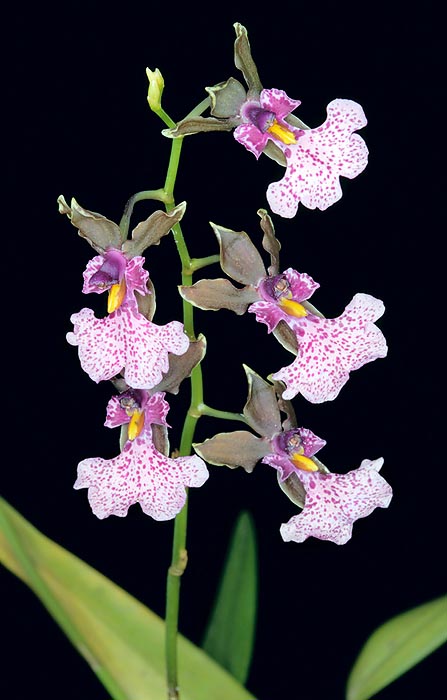Family : Orchidaceae

Text © Pietro Puccio

English translation by Mario Beltramini

Very ornamental, Caucacea olivacea is difficult to cultivate © Giuseppe Mazza
The name of the genus refers to the Cauca Department in Colombia, where the species type has been originally collected; the name of the species is the Latin adjective “olivacea” = of olive colour, with reference to the colour of sepals and petals.
The Caucaea olivacea (Kunth) N.H.Williams & M.W.Chase (2001) is a rather variable epiphytic or terrestrial species, with ovoid, close together, pseudobulbs, slightly compressed, of 2-7 cm of length and of 1-2,5 cm of thickness, covered by several imbricate foliar sheaths, with at the apex, 1-2 coriaceous, oblong-lanceolate leaves, 15-20 cm long and 1,5-3,5 cm broad.
Inflorescences from the base of the pseudobulb, long up to 60 cm, initially erect, then curved, carrying a variable number of flowers slightly perfumed and long-lasting, of about 3-3,5 cm of diameter, with concave sepals and petals of dark brown colour edged of olive green, at times wholly olive green, and labellum from white to dark pink spotted of purple red.
The dorsal sepal is oblong with sharp apex, 14 mm long and 6 mm broad, the lateral ones, bonded together but at the bifid apex, are 14 mm long and 8 mm broad; the petals are oblong, of about the same length as the sepals and 8 mm broad; the labellum is trilobate, 3 cm long and 3,2 cm broad, with median lobe bilobed at the apex, a yellow crest at the base and wavy edges.
It reproduces by seed, in vitro, and by division at the moment of the vegetative regrowth with each section provided with at least of 3-4 pseudobulbs.
It is a very ornamental species but quite difficult to cultivate as it is not easy to reproduce the conditions of its natural environment, very windy and characterized by cool temperatures, practically constant, between the 12 and the 20 °C, and high and constant humidity, 60-90%.
It requires a slightly shaded position and regular waterings and nebulisations during the growth period, reduced at the moment of the emission of the inflorescences in order to avoid their loss, as they are sensitive to rottenness.
The watering and nebulisations are to be done with rain water, or water obtained by reverse osmosis or demineralised, and the fertilizations, during the vegetative period, with hydro-soluble balanced products, with microelements, at ¼ of the dosage suggested on the package, distributed and alternated in way to avoid salts accumulation on the roots.
It can be mounted on bark or on a cork raft, or cultivated in pot with draining and quite aerated compost, which may be formed by medium sliced bark fragments and charcoal; movements, repottings and divisions are to be made when the plant gives signs of vegetative regrowth.
The species is inscribed into the appendix II of the CITES (species whose trade is internationally ruled).
Synonyms: Oncidium olivaceum Kunth (1816); Oncidium cucullatum Lindl. (1838); Oncidium rhodostictum Kraenzl. (1922); Oncidium kennedyi Stacy (2001); Caucaea cucullata (Lindl.) N.H.Williams & M.W.Chase (2001); Caucaea kennedyi (Stacy) N.H.Williams & M.W.Chase (2001); Caucaea rhodosticta (Kraenzl.) N.H.Williams & M.W.Chase (2001).
→ For general notions about ORCHIDACEAE please click here.
